 The state funeral of Britain’s former prime minister and wartime hero Sir Winston Churchill in 1965 was a brilliant spectacle watched by more than 350 million people around the world. Here, author Piers Brendon explores the top-secret plans in place for the funeral and reveals the true nature of Churchill’s relationship with Queen Elizabeth II…
The state funeral of Britain’s former prime minister and wartime hero Sir Winston Churchill in 1965 was a brilliant spectacle watched by more than 350 million people around the world. Here, author Piers Brendon explores the top-secret plans in place for the funeral and reveals the true nature of Churchill’s relationship with Queen Elizabeth II…
How and when did Winston Churchill die?
Sir Winston Churchill died on 24 January 1965 – 70 years to the day after the death of his father. He was 90 years old and had suffered a series of strokes, and it had been apparent for some time that his life was drawing to a close. Reporters besieged his London house at Hyde Park Gate and the state of his health filled the newspapers. With characteristic good taste, the new satirical magazine Private Eye referred to him as “the greatest dying Englishman”.
Actually, Churchill’s health had been in decline at least since the major stroke which felled him in June 1953. Then, the prime minister’s incapacitation was kept hidden from the public while he made a very slow recovery. This was a remarkable example of British official secrecy at work and a stark contrast to what happened in America after Dwight Eisenhower’s heart attack two years later, when the White House press secretary issued regular bulletins about the president’s condition, right down to the nature and rate of his bowel movements.
Plans for Churchill’s funeral were initiated after his stroke and they too were a closely guarded secret. His funeral took place on 30 January 1965.
Operation Hope Not: what plans were in place for Churchill’s funeral?
Queen Elizabeth II instructed the Duke of Norfolk, who as hereditary Earl Marshal of England was in charge of important ceremonial occasions, to ensure that the wartime leader’s obsequies were “on a scale befitting his position in history”. A Whitehall committee was therefore established, on which Churchill’s private secretary Anthony Montague Browne sat, to work out a programme for a state funeral. Asked by Churchill’s son, Randolph, what a state funeral was, the Earl Marshal replied succinctly: “One for which the state pays.” (Churchill’s funeral cost £55,000, not counting the military expenditure.)
Drawing on precedents set during the last offices accorded to national figures such as Nelson, Wellington and Gladstone, the committee devised an astonishingly detailed programme for a gigantic funereal pageant – the last great imperial pageant – full of pomp and circumstance. The functions of all the participants were laid out with minute precision; their movements were orchestrated to the second and choreographed to the inch. The arrangements were embodied in a so-called ‘war book’, as though for another D-Day, and the entire procedure was code-named Operation Hope Not.
Did Churchill help plan his own funeral?
Contrary to myth, Churchill himself was not much involved in the planning. But he did express the hope that his send-off would be accompanied by plenty of bands (he got nine) and that the hymns should be lively – they were characteristically pugnacious: ‘Fight the Good Fight’; ‘He Who Would Valiant Be’; and ‘The Battle Hymn of the Republic’. However, Churchill did manage to interfere with the arrangements by sheer longevity. According to the joke which Lord Mountbatten liked to repeat: “Winston kept living and the pallbearers kept dying.”
Churchill had also changed his mind in one significant respect: he originally wanted to be cremated and to have his ashes interred alongside the bodies of his beloved pets at Chartwell (you can read more about Churchill’s pets in my book Churchill’s Bestiary: His Life Through Animals); instead he decided that his corpse should be buried in Bladon churchyard, close to his parents’ graves and to his birthplace, Blenheim Palace.
Bladon also gave him an opportunity. Churchill was averse to the attendance at his funeral service of his infuriating wartime ally General Charles de Gaulle, who was engaged during the 1960s in frustrating Britain’s efforts to join the European Economic Community (EEC). However, Churchill agreed to the general’s presence on condition that the train taking his body to its final resting-place did not leave from Paddington but from Waterloo – a wicked posthumous putdown.
What was Churchill’s relationship with Queen Elizabeth II?
On Churchill’s death the Queen wrote to his widow, Clementine:
“The whole world is poorer for the loss of this many-sided genius, while the survival of this country and the sister nations of the Commonwealth, in the face of the greatest danger that has ever threatened them, will be a perpetual memorial to his leadership, his vision and indomitable courage.”
All told, it was a brilliant spectacle, impeccably executed. Yet its most poignant element was unplanned and apparently spontaneous. As the Haven gore made its way down the Thames, dockside cranes dipped their jibs in homage to the saviour of the nation, bowing their long necks like metal plesiosauruses and, incidentally, facing extinction as London (still scarred by the war) ceased to be what it had been, the trading hub of the workshop of the world and the entrepot of the British empire. Later that evening an exhausted Clementine said to her youngest daughter: “You know, Mary, it wasn’t a funeral, it was a Triumph.”
But was it? Churchill’s death coincided with the end of the empire, something he had feared and resisted all his life. De Gaulle therefore had some reason to declare (with relish) upon Churchill’s death: “Now Britain is no longer a great power.” Actually, Britain’s power had been waning for years. However, Churchill’s passing dramatised the country’s relative decline and even perhaps presaged its fall. The Labour politician Richard Crossman wrote: “It felt like the end of an epoch, possibly even the end of a nation.”
At Churchill’s funeral the British people were not just mourning a national hero. They were grieving over a potent symbol of their lost greatness and their finest hour.



